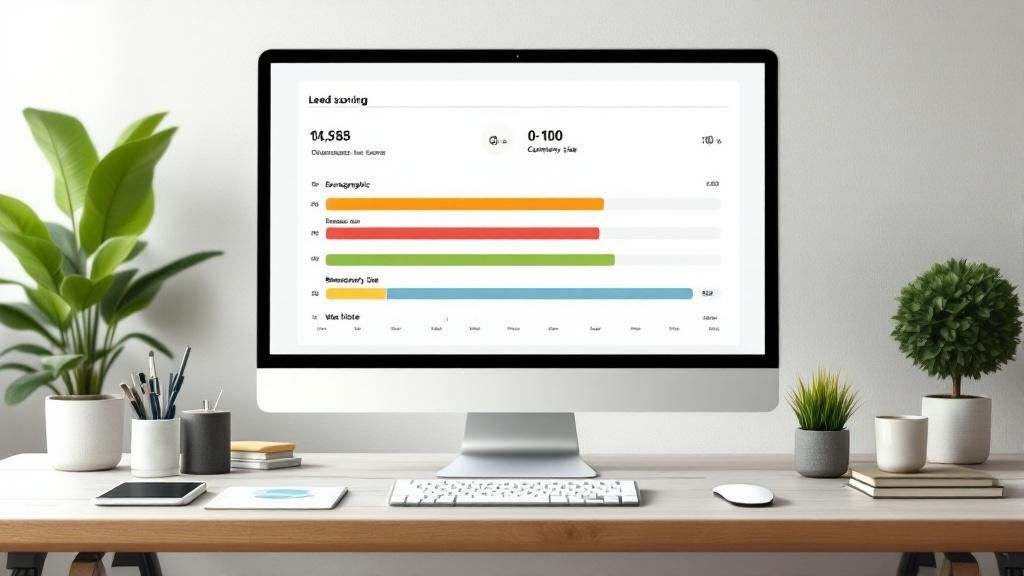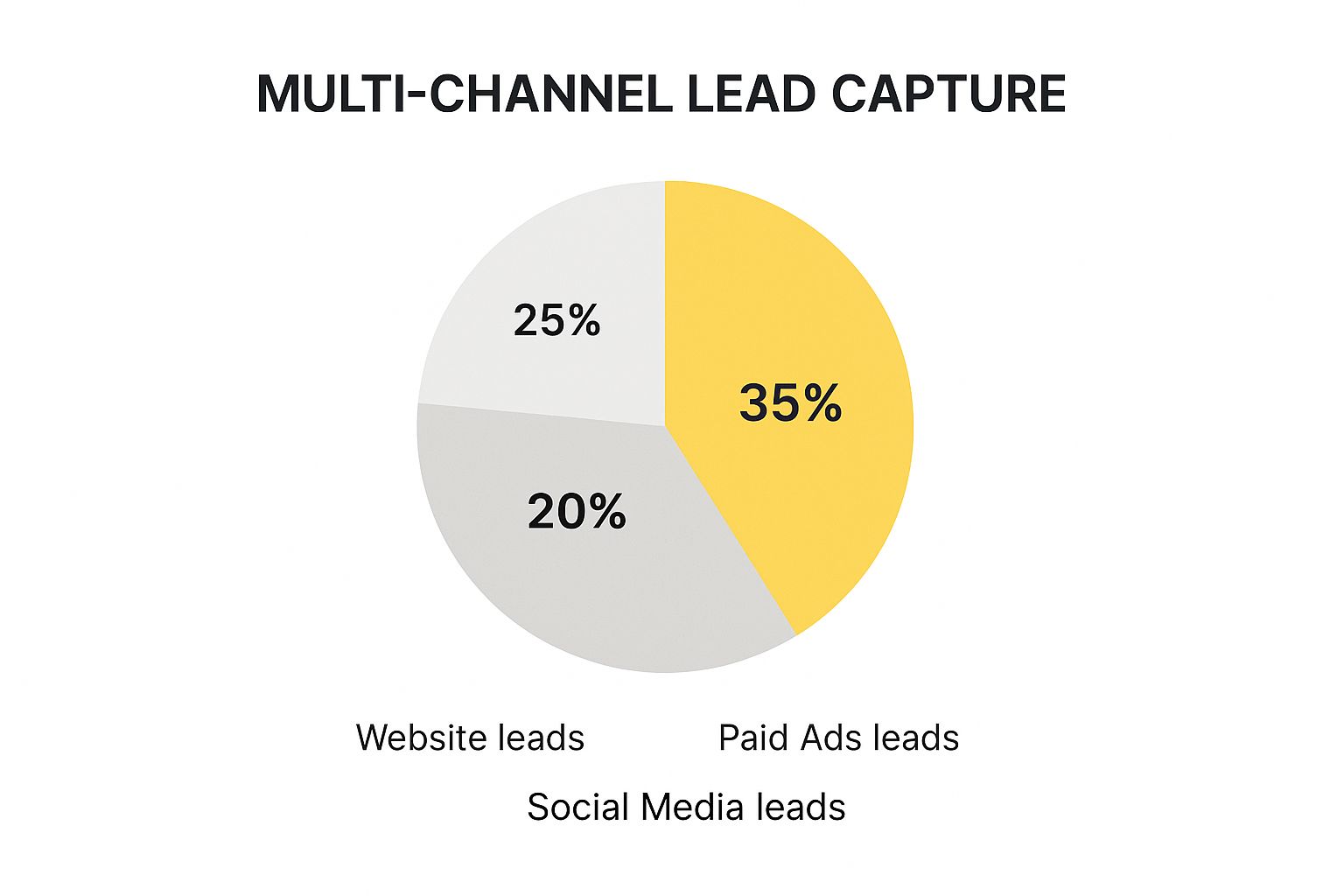In a competitive market, every lead is a valuable opportunity. However, without a structured approach, potential revenue can easily slip through the cracks. Effective lead management isn't just about collecting contacts; it's a systematic process of capturing, qualifying, nurturing, and converting prospects into loyal customers. For busy professionals like real estate agents, mortgage brokers, and small business owners, mastering this process can mean the difference between stagnation and exponential growth. This is where implementing proven lead management best practices becomes a game-changer.
This guide explores eight essential strategies designed to optimise your sales funnel, enhance efficiency, and maximise your return on investment. Forget generic advice; we'll provide actionable insights and practical examples tailored for real-world application. You will learn how to implement robust systems for scoring, responding to, and nurturing leads effectively.
We will also demonstrate how tools like OnSilent can help you centralise communication and automate key tasks, ensuring no opportunity is ever missed. By applying these methods, you can save significant time, build stronger customer relationships, and drive tangible results for your business. Let's dive into the practices that will transform your lead conversion rates.
1. Institute a Robust Lead Scoring and Qualification Framework
One of the most impactful lead management best practices is to stop treating all incoming leads as equals. A systematic approach to scoring and qualifying leads is fundamental to separating high-potential prospects from those who are just browsing. This process involves assigning points to leads based on specific criteria, allowing your sales team to focus their energy where it will yield the best results.

This framework helps you prioritise your follow-up efforts, significantly improving efficiency and conversion rates. For example, a real estate lead who repeatedly views a specific high-value listing and downloads a 'Guide to Buying' eBook is far more valuable than a lead who only visited your homepage once. Scoring formalises this distinction. Platforms like HubSpot have proven this model's success, helping companies like Omnikick boost qualified leads by 70%.
How to Implement Lead Scoring
Implementing a lead scoring system doesn't have to be complex. The goal is to create a clear, repeatable process that aligns with your business goals.
- Define Your Criteria: Start by identifying the key attributes of your ideal customer. This includes explicit data (demographics like job title or location) and implicit data (behaviours like website pages visited or emails opened).
- Assign Point Values: Allocate points to each criterion. For instance, a lead from your target post code might get +10 points, while visiting your pricing page could add another +15.
- Set Score Thresholds: Establish clear benchmarks. A lead scoring 0-49 might be a "Nurture" lead, 50-99 becomes a "Marketing Qualified Lead" (MQL), and 100+ is a "Sales Qualified Lead" (SQL) ready for immediate contact.
- Introduce Negative Scoring: To maintain a clean pipeline, subtract points for undesirable traits. A student email address or activity from a competitor could trigger a negative score, automatically disqualifying poor-fit leads.
- Review and Refine: Your scoring model is not static. Regularly analyse which lead scores correlate with actual sales conversions and adjust your criteria accordingly to improve accuracy.
2. Implement a Rapid Lead Response Strategy
In today's fast-paced digital world, speed is not just a competitive advantage; it's a necessity. Another core tenet of effective lead management best practices is establishing a rapid response system. The window of opportunity to engage a new lead is incredibly small, and delaying contact by even a few minutes can dramatically reduce your chances of qualifying them.

Groundbreaking research popularised by InsideSales.com and Velocify highlights this urgency. Studies show that contacting a lead within the first five minutes can increase qualification rates by over 21 times. The simple truth is that when a prospect reaches out, their interest and intent are at their peak. A swift, professional response captures that momentum, whereas a slow one allows their attention to drift to your competitors. This principle is vital for professionals like real estate agents and mortgage brokers, where timing can make or break a deal.
How to Implement Rapid Lead Response
Building a system for immediate follow-up requires a combination of technology, processes, and a team-wide commitment to speed.
- Automate Lead Routing: Instantly assign new leads to the next available sales representative using your CRM or a tool like OnSilent. This eliminates manual assignment delays and ensures no lead is left waiting.
- Leverage Immediate Acknowledgement: Set up an automated email or SMS to send the moment a lead submits a form. This message confirms receipt and sets the expectation that a team member will be in touch shortly, buying you valuable time.
- Create Response Templates: Equip your team with pre-written, customisable templates for common enquiries. This allows for a fast, yet personalised, initial contact without having to write every message from scratch.
- Enable Mobile Response: Ensure your team can respond from anywhere. Using mobile apps for your CRM and communication tools means a lead who submits an enquiry after hours or on a weekend can still receive a timely reply. For a deeper dive into this, explore our guide on call handling best practices.
- Track and Measure Response Times: You can't improve what you don't measure. Monitor your team's average lead response time and set clear KPIs to drive continuous improvement and accountability.
3. Implement Automated Lead Nurturing Campaigns
Not every lead is ready to buy the moment they connect with you. A crucial lead management best practice is to build relationships with these prospects over time through automated lead nurturing campaigns. This systematic process uses targeted, personalised communication to guide leads through their buyer's journey, keeping your business top-of-mind until they are ready to make a decision.

Effective nurturing provides value first, building trust and positioning you as an authority. Instead of sending generic sales pitches, you deliver relevant content that educates and solves problems for your prospects. The power of this approach is well-documented; for example, marketing automation leader Marketo used lead nurturing to help its client Polycom achieve a 45% increase in sales opportunities by engaging leads with the right message at the right time.
How to Implement Lead Nurturing
Creating successful nurturing campaigns requires a strategic, customer-centric approach. The aim is to make your communication feel personal and timely, even when it's automated.
- Segment Your Audience: Group your leads based on shared characteristics like their industry, interests, or stage in the sales funnel. A mortgage broker might create separate nurturing streams for first-home buyers versus seasoned investors.
- Provide Valuable Content: Move beyond purely promotional material. Share educational blog posts, how-to guides, case studies, or market reports that address your audience's pain points and help them make an informed decision.
- Use Behavioural Triggers: Set up automations that send specific messages based on a lead's actions. If a real estate lead downloads a "Guide to Downsizing", trigger a sequence with content about local market trends for smaller properties. This is a core part of an effective real estate follow up system.
- Include Clear Calls-to-Action (CTAs): Each communication should have a clear next step. Encourage leads to book a consultation, download another resource, or visit a specific page, gently guiding them toward a sale.
- Test and Optimise: Continuously monitor your campaign performance. Test different email subject lines, content formats, and sending frequencies to see what resonates best with your audience and refine your strategy for better results.
4. CRM Integration and Data Management
A cornerstone of effective lead management best practices is centralising all lead data within a robust Customer Relationship Management (CRM) system. Without a single source of truth, lead information becomes fragmented across spreadsheets, email inboxes, and individual notes, making consistent follow-up and accurate reporting impossible. Integrating your CRM with all other business tools ensures data is consistent, accessible, and actionable across every touchpoint.
This centralised approach empowers your entire organisation, from marketing to sales to customer service, with a complete 360-degree view of every prospect. For instance, a real estate agent can see if a lead has opened their latest marketing email, visited a specific property listing online, and previously enquired about a different suburb, all in one unified record. This level of insight is transformative, as demonstrated by industry leaders like Salesforce, which helped T-Mobile improve lead conversion by 25% through better data centralisation.
How to Implement CRM Integration and Data Management
Putting your CRM at the heart of your operations requires a strategic approach focused on data quality and system connectivity.
- Establish Clear Data Entry Standards: Create a documented policy for how data is entered into the CRM. Define mandatory fields, formatting rules (e.g., phone numbers, addresses), and naming conventions, and ensure all team members are trained on these standards.
- Automate Data Validation: Use your CRM's built-in features to create rules that prevent incorrect data from being saved. This could include requiring a valid email format or ensuring a post code is entered correctly, which is vital for property and trade businesses.
- Regularly Audit and Cleanse Data: Schedule routine data hygiene tasks. Use deduplication tools to merge duplicate records, run reports to find incomplete entries, and purge outdated or irrelevant contacts to keep your database clean and efficient.
- Integrate Key Business Tools: Connect your CRM with other essential platforms like your website forms, marketing automation software (e.g., Mailchimp), and quoting tools. Use native integrations or third-party connectors like Zapier to automate the flow of information.
- Create Role-Specific Dashboards: Customise CRM dashboards for different user roles. A sales manager needs a high-level view of the team's pipeline and conversion rates, while an individual agent needs to see their daily tasks and active leads, ensuring everyone has the right information at a glance.
5. Employ Multi-Channel Lead Capture
Relying on a single source for new business is a risky strategy. One of the most critical lead management best practices is to diversify your lead generation efforts by capturing prospects across multiple channels. This means meeting potential customers where they are most active, whether that’s on your website, scrolling through social media, attending an industry event, or engaging with your content.

This pie chart visualises a typical breakdown of lead sources for a business with a diversified strategy, highlighting the importance of not over-relying on a single channel. The data clearly shows that while a company's website often remains a primary source, paid advertising and social media contribute significantly to the overall lead volume, underscoring the need for a balanced, multi-channel approach. Platforms like LinkedIn have helped B2B companies boost conversions by up to 25% with their native Lead Gen Forms, demonstrating the power of a channel-specific strategy.
How to Implement Multi-Channel Capture
Creating a cohesive multi-channel strategy involves more than just being present everywhere. It requires a coordinated effort to ensure a seamless customer experience and accurate tracking.
- Optimise for Each Channel: Tailor your lead capture forms and offers to the platform. For example, use simplified forms on mobile-first channels like Facebook and Instagram, while your website might feature more detailed forms for high-intent actions like requesting a quote.
- Use UTM Parameters for Tracking: To understand which channels deliver the best results, append UTM parameters to every link you share. This allows you to accurately attribute leads in your analytics or CRM, providing clear data on your marketing ROI.
- Maintain Brand Consistency: While your approach may be tailored, your branding and core messaging must remain consistent. A lead should have a familiar experience whether they find you through a Google Ad, a LinkedIn post, or a referral link.
- Implement Progressive Profiling: To reduce friction on return visits, use smart forms that recognise a lead and ask for new information instead of repeating fields. For instance, if you already have their name and email, the form might next ask for their company size or specific interest.
- A/B Test Your Offers: Continuously test different calls-to-action (CTAs), headlines, and offers on each channel to see what resonates most with that specific audience. A free property valuation might perform well on Facebook, while a detailed market report could be more effective on LinkedIn.
6. Formalise a Sales and Marketing Service Level Agreement (SLA)
A critical component of effective lead management best practices is breaking down the traditional silos between sales and marketing. A formal Service Level Agreement (SLA) is the bridge that connects these two departments, creating a unified front focused on a single objective: converting leads into customers. This agreement documents mutual commitments, defines roles, and establishes shared metrics for success.
When both teams operate under a clear, agreed-upon framework, friction disappears, and efficiency skyrockets. Instead of marketing tossing leads over the fence and sales complaining about quality, the SLA ensures a smooth, accountable handoff. Companies that pioneer this alignment, like Marketo, have seen clients achieve a staggering 209% increase in marketing-generated revenue. This demonstrates that a formalised partnership is not just administrative; it’s a powerful growth driver.
How to Implement a Sales and Marketing SLA
Building an effective SLA requires collaboration and a commitment to shared success. It transforms your lead management from a disjointed process into a well-oiled machine.
- Define Your Lead Stages: Collaboratively define the exact criteria for a Marketing Qualified Lead (MQL) and a Sales Qualified Lead (SQL). What specific actions, demographics, or scores must a lead have for marketing to pass it to sales?
- Establish Mutual Goals: Set shared Key Performance Indicators (KPIs) that both teams are responsible for, such as pipeline velocity, lead-to-customer conversion rate, and overall revenue contribution.
- Document Handoff and Follow-up Protocols: Clearly outline the process for handing over a qualified lead. Specify the expected response time from the sales team (e.g., within 2 hours for an SQL) and the number of follow-up attempts required before a lead is returned to marketing for further nurturing.
- Create a Feedback Loop: Schedule regular meetings between sales and marketing leaders to review performance against the SLA. This is a crucial forum for discussing lead quality, refining qualification criteria, and optimising campaigns based on real-world sales outcomes.
- Use Technology to Automate: Leverage your CRM or a platform like OnSilent to automate the lead handoff process. Use workflows to assign leads to the correct sales representative and trigger notifications, ensuring the SLA’s timeframes are consistently met.
7. Lead Analytics and Performance Tracking
To truly master your pipeline, you must move beyond simply generating leads and embrace comprehensive measurement. Implementing lead management best practices means meticulously tracking and analysing performance metrics to optimise your entire strategy. This involves understanding where your best leads come from, how quickly they convert, and what their ultimate value is to your business.
This data-driven approach removes guesswork, allowing you to allocate your marketing budget more effectively and refine your sales process for maximum impact. For example, a property manager might discover through analytics that leads from a specific local community Facebook group have a 30% higher conversion rate than leads from a national real estate portal, prompting a shift in advertising spend. Platforms like Salesforce Analytics have empowered businesses to improve lead conversion rates by as much as 30% by providing this level of insight.
How to Implement Lead Analytics
Building an effective analytics framework is about focusing on the metrics that matter and creating a system for regular review.
- Establish UTM Tracking: Consistently use UTM parameters for all digital campaigns. This allows you to accurately track every lead back to its source, channel, and specific campaign, whether it’s a social media ad or an email newsletter.
- Implement Multi-Touch Attribution: Very few leads convert after a single interaction. Use multi-touch attribution models to understand the entire customer journey and give credit to the various touchpoints that influenced a sale, not just the last one.
- Create Centralised Dashboards: Consolidate your key metrics into a single, easy-to-read dashboard. Track lead sources, conversion rates by stage, cost per lead, and time to conversion. This provides an at-a-glance view of your pipeline's health.
- Focus on Revenue Metrics: While lead volume is important, the ultimate goal is revenue. Prioritise metrics like Customer Lifetime Value (CLV) and Return on Investment (ROI) by lead source to ensure your efforts are profitable. To dig deeper into what to track, you can explore more about communication metrics to guide your strategy.
- Conduct Regular Audits: Data accuracy is paramount. Schedule regular audits of your tracking implementation to find and fix any broken links, incorrect tagging, or data discrepancies before they skew your strategic decisions.
8. Lead Recycling and Re-engagement
Not every lead is ready to buy the first time you connect. An often-overlooked but powerful lead management best practice is creating a system for lead recycling. This involves strategically re-engaging with leads that went cold or were disqualified, recognising that their circumstances, needs, or timing might have changed. Instead of deleting dormant contacts, you place them into a long-term nurturing process designed to revive their interest.
This approach prevents you from losing potentially valuable opportunities forever. A prospect who wasn't ready six months ago might have a new budget or a more pressing need today. Platforms like Marketo have championed this strategy, helping companies recover up to 25% of opportunities that were initially considered lost. Similarly, HubSpot's lifecycle automation can drive a 15-20% increase in total conversions by systematically re-engaging dormant segments.
How to Implement Lead Recycling
Building a successful lead recycling program requires a thoughtful and patient approach. It's about re-establishing value, not just sending more emails.
- Define a "Cooling-Off" Period: Don't re-engage too soon. Allow a suitable amount of time to pass, typically 6-12 months, before re-initiating contact. This prevents fatigue and ensures circumstances may have genuinely changed.
- Segment by Disqualification Reason: Group dormant leads based on why they didn't convert initially. Was it budget, timing, or a missing feature? Tailor your re-engagement message to address that original objection.
- Use Fresh Messaging and Offers: Your original pitch didn't work, so don't repeat it. Offer new content, a case study relevant to their industry, an invitation to a webinar, or a special re-introductory offer to reignite the conversation.
- Monitor Re-engagement Signals: Track opens, clicks, and website visits from your recycling campaigns. A sudden spike in activity is a clear trigger to move that lead back into the active sales pipeline for personalised follow-up.
- Maintain List Health: Always provide a clear and easy way for contacts to opt out. A clean list is more effective and ensures you respect your audience's preferences, which is crucial for long-term brand reputation.
Lead Management Best Practices Comparison
| Item | Implementation Complexity 🔄 | Resource Requirements ⚡ | Expected Outcomes 📊 | Ideal Use Cases 💡 | Key Advantages ⭐ |
|---|---|---|---|---|---|
| Lead Scoring and Qualification | Medium-High: Setup 2-4 weeks, optimization 3-6 months | Moderate: CRM integration, ongoing maintenance | Increases conversion by 30-50% | Prioritizing high-value leads in sales pipeline | Improves sales focus, data-driven insights |
| Rapid Lead Response | Medium-High: Requires 24/7 coverage or automation | High: Automation, real-time notifications | Up to 400% increase in lead qualification | Responding instantly to inbound leads | Maximizes conversion through fast engagement |
| Lead Nurturing Campaigns | High: Complex with automated sequences and content creation | High: Content production, marketing automation | 20-30% increase in conversion rates | Long buyer journeys needing relationship building | Scales personalized communication |
| CRM Integration & Data Management | High: Initial setup and ongoing governance | High: Integration, data hygiene, user training | Improves lead tracking and conversion by 25-40% | Centralized data management and collaboration | Eliminates silos, improves reporting |
| Multi-Channel Lead Capture | Medium-High: Managing multiple channels | High: Resources across channels, tracking tools | Increases lead volume and diversifies sources | Capturing leads across varied customer touchpoints | Expands reach, reduces channel dependency |
| Sales and Marketing Alignment | Medium: Requires ongoing management and enforcement | Moderate: Coordination and communication tools | Improves conversions by 67%, higher win rates | Aligning teams to improve lead handoff and quality | Enhances accountability, consistent messaging |
| Lead Analytics & Performance Tracking | High: Sophisticated tools and analyst resources | High: Analytics platforms, dedicated staff | Optimizes budget, improves conversion by 20-30% | Data-driven optimization of lead management | Reveals bottlenecks, improves ROI allocation |
| Lead Recycling and Re-engagement | Medium: Requires automation and segmentation | Moderate: Campaign design and timing controls | 15-30% recycled leads convert, 20-25% ROI gain | Re-engaging dormant or lost leads | Maximizes existing lead investments |
Transform Your Approach and Drive Sustainable Growth
Mastering lead management is no longer a luxury reserved for large enterprises; it is the fundamental engine for sustainable growth for businesses of all sizes, from solo real estate agents to thriving trade companies. Moving beyond a haphazard approach to a structured system is what separates stagnant pipelines from predictable revenue streams. The journey we have explored through these lead management best practices is not about implementing a single, magical fix. Instead, it’s about architecting a cohesive, intelligent framework that honours the value of every single prospect who shows interest in your business.
By embracing this strategic mindset, you transform your daily operations. Rapid lead response ceases to be a frantic scramble and becomes a systemised, high-impact first impression. Lead nurturing evolves from sporadic check-ins into automated, personalised journeys that build trust and keep your brand top-of-mind. This structured approach, underpinned by robust data and analytics, is the key to unlocking consistent success.
Key Takeaways for Immediate Action
To truly revolutionise your process, focus on integrating these core principles into a unified strategy. Think of it not as a checklist, but as interconnected gears in your revenue machine.
- Speed and Structure: The synergy between rapid response and strategic nurturing is your most powerful combination. Immediate engagement captures initial interest, while thoughtful follow-up campaigns convert that interest into intent.
- Intelligence and Alignment: Effective lead scoring and a clear Sales and Marketing SLA ensure that your team's valuable time is spent on the most promising opportunities. This alignment prevents high-quality leads from falling through the cracks and ensures everyone is working towards the same goal.
- Data-Driven Optimisation: What isn't measured cannot be improved. Consistently tracking lead analytics and actively recycling old leads are non-negotiable practices. This is how you turn your lead database from a simple list into a valuable, appreciating asset.
Your Path Forward
Implementing these lead management best practices is a commitment to operational excellence. It’s a declaration that you value every lead and are dedicated to providing an exceptional experience from the very first click. By integrating robust CRM practices, aligning your teams, and leveraging automation to handle the crucial initial touchpoints, you build more than just a sales funnel; you build a predictable, scalable, and highly efficient growth engine. This disciplined approach is what empowers you to not only survive but thrive in a competitive marketplace, turning potential interest into profitable, long-term customer relationships.
Ready to perfect your rapid lead response and ensure no opportunity is ever missed? See how OnSilent can automate your initial contact, engage leads 24/7, and seamlessly integrate into your lead management workflow. Explore OnSilent today and start turning more leads into conversations.

